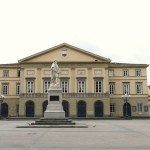 In the current world of funding cuts, and political squabbles seemingly affecting every theatre in Italy, Lucca’s included, it may be a good time for a moment of reflection. For almost 200 years, the Teatro del Giglio in Lucca has been at the centre of the city’s artistic, musical and cultural life – “a little jewel set in the ring of the city walls”.
In the current world of funding cuts, and political squabbles seemingly affecting every theatre in Italy, Lucca’s included, it may be a good time for a moment of reflection. For almost 200 years, the Teatro del Giglio in Lucca has been at the centre of the city’s artistic, musical and cultural life – “a little jewel set in the ring of the city walls”.
The theatre owes its present form to the outbreak of creative energy which burst upon Lucca in the early 1800s, driven not least by two formidable women, first Elisa Baciocchi, Napoleon’s sister who ruled Lucca from 1805 till 1814, and later Maria Luisa di Borbone (that’s her statue in the middle of Piazza Napoleone.)
It was the latter who in1817 commissioned the architect Giovanni Lazzarini to restore and expand the existing Teatro Nazionale, and provide for it an elegant urban setting in keeping with Bourbon taste. The result is the theatre as we now know it, shown to advantage in its own handsome square, and with perspectives across the tree-lined Piazza Napoleone itself.
The origins of theatre in Lucca of course go back much further, to the 17th Century in fact, when performances were held in the Teatro dei Borghi, and the Sala del Podestà, which later became the Palazzo Pretorio, the building with the loggia on the corner of Piazza San Michele and via Vittorio Veneto. Later, of course, the grand palazzi of the lucchese nobility lent themselves to staging theatrical performances, and in the heyday of the silk trade as Lucca became a mecca for merchants from all over the known world, with the means to enjoy the finer things of life, it was not long before the city commissioned its first public theatre.
This was the Teatro San Girolamo, (attached to the present theatre and now once again happily in use) converted from a Jesuit convent in the 17th century. It was later joined by several privately-run theatres – the Pantera, the Castiglioncelli, and the Goldoni.
Lazzaroni’s task was to take the Teatro Nazionale, as the Teatro San Girolamo had become, and adapt it and its setting to suit the prevailing French taste in Lucca in the early 1800s for splendid open spaces showing buildings to their best advantage. In effect he extended the building to face into what is now Piazza del Giglio, leading into Piazza Napoleone. It is a tribute to his achievement that the theatre and its surroundings remain largely unchanged today.
A new theatre demanded a new name, and Maria Luisa, true to her Bourbon roots chose the giglio – the lily or fleur de lys, from the family coat of arms. And fittingly, it was a work by the composer of the moment Gioachino Rossini which opened the new theatre in 1819, when his “Aureliano in Palmira” was performed.
While the work is not often heard nowadays, Rossini, typically, later re-used much of it in “The Barber of Seville”. (And in fact if you want to track it down, there is a recording of it from 1995, featuring the orchestra of none other than the Teatro del Giglio.) Since that night in 1819, the theatre has, besides its drama and dance programmes, hosted all the great names of Italian opera, and some of its most famous conductors.
In the early days, Bellini, Rossini and Donizetti came in person to present new works, and the soprano Maria Malibran had a huge success, sending her audience delirious according to contemporary reports. In 1836 the star soprano at the Giglio in Donizetti’s “Lucia di Lammermoor” was Giuseppina Strepponi, later to become the wife of Giuseppe Verdi. In the latter half of the 19th century, Verdi’s works became increasingly popular as patriotic fervour in Italy grew.
From the 1870s onwards in fact, the theatre – by now lit by gas rather than oil lamps – began its truly golden period when there was rarely a seat to be had at performances, particularly of lucchesi composers – Puccini of course, although none of his works had their premiere there, and Catalani, whose “La Wally” was conducted by the great Arturo Toscanini.
The tradition persisted into the 20th century, when despite long periods of closure during two World Wars, the theatre continued to host great conductors and singers, among them Carlo Tagliavini, Maria Caniglia, Mario Del Monaco, Giuseppe Di Stefano, and – as Rodolfo in Puccini’s “La Bohème” in the early1960s – a certain young tenor Luciano Pavarotti.
Sadly, these golden days of ten or twelve operas each year are now gone, but the lucchesi can still dream of their theatre as La Scala in miniature, as Lucio D’Ambra described it, “…il Giglio, una piccola Scala…..”
0 Comments